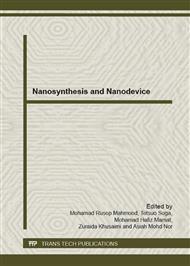p.35
p.43
p.48
p.53
p.58
p.63
p.68
p.74
p.80
Structural, Optical and Electrical Properties of Titanium Dioxide Thin Films with Different Molarity
Abstract:
Titanium dioxide, TiO2 is one of the semiconductor materials that can be produced in many ways, such as magnetron sputtering, CVD, and sol-gel process. This paper studied on the production of TiO2 by sol-gel method using titanium tetra (IV) isopropoxide, TTiP. The solution of TiO2 then deposited as a thin films onto glass substrate by spin-coating method. The purpose of this paper is to investigate the effect of molarity on the morphology, optical and electrical properties of the thin films. The effect on the morphology was observed by AFM. The electrical properties then observed by IV characteristic and finally on the optical properties were investigated by UV-Vis. The transmission obtained from UV-Vis showed that TiO2 thin films are decreased around 18% at higher molarity in a visible region. The bandgap also decrease at high molarity. Higher molarity of TiO2 in current-voltage characteristic gave a value of current density for 1.03×10-4 A/m2 and resistivity 1.95×107 Ωm.
Info:
Periodical:
Pages:
58-62
Citation:
Online since:
March 2013
Authors:
Keywords:
Price:
Сopyright:
© 2013 Trans Tech Publications Ltd. All Rights Reserved
Share:
Citation:


